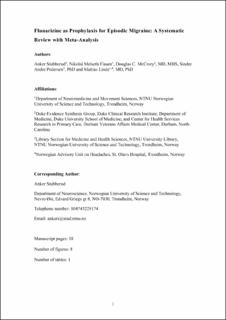Flunarizine as prophylaxis for episodic migraine: a systematic review with meta-analysis
Stubberud, Anker; Flaaen, Nikolas Melseth; McCrory, Douglas C.; Pedersen, Sindre Andre; Linde, Mattias
Peer reviewed, Journal article
Accepted version

View/
Date
2019Metadata
Show full item recordCollections
Abstract
Based on few clinical trials, flunarizine is considered a first-line prophylactic treatment for migraine in several guidelines. In this meta-analysis, we examined the pooled evidence for its effectiveness, tolerability, and safety. Prospective randomized controlled trials of flunarizine as a prophylaxis against migraine were identified from a systematic literature search, and risk of bias was assessed for all included studies. Reduction in mean attack frequency was estimated by calculating the mean difference (MD), and a series of secondary outcomes—including adverse events (AEs)—were also analyzed. The database search yielded 879 unique records. Twenty-five studies were included in data synthesis. We scored 31/175 risk of bias items as “high,” with attrition as the most frequent bias. A pooled analysis estimated that flunarizine reduces the headache frequency by 0.4 attacks per 4 weeks compared with placebo (5 trials, 249 participants: MD 20.44; 95% confidence interval 20.61 to 2 0.26). Analysis also revealed that the effectiveness of flunarizine prophylaxis is comparable with that of propranolol (7 trials, 1151 participants, MD 20.08; 95% confidence interval 20.34 to 0.18). Flunarizine also seems to be effective in children. The most frequent AEs were sedation and weight increase. Meta-analyses were robust and homogenous, although several of the included trials potentially suffered from high risk of bias. Unfortunately, reporting of AEs was inconsistent and limited. In conclusion, pooled analysis of data from partially outdated trials shows that 10-mg flunarizine per day is effective and well tolerated in treating episodic migraine—supporting current guideline recommendations.